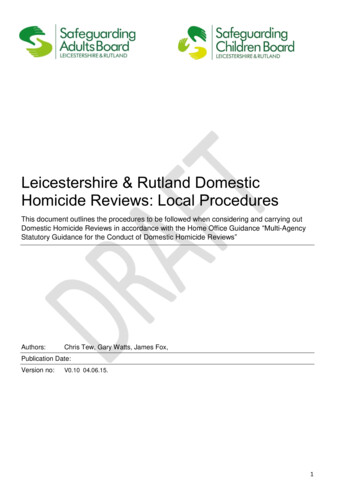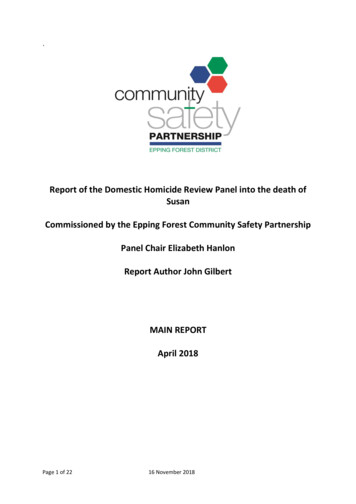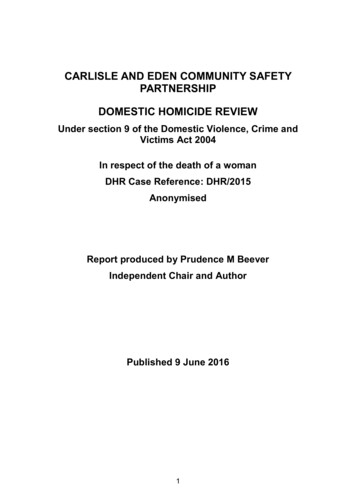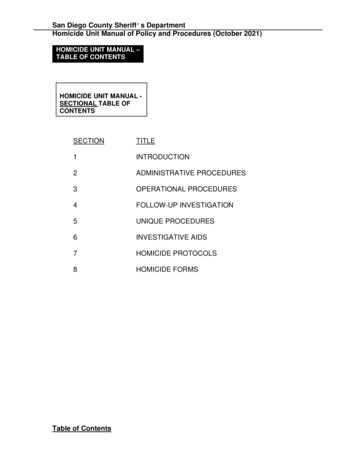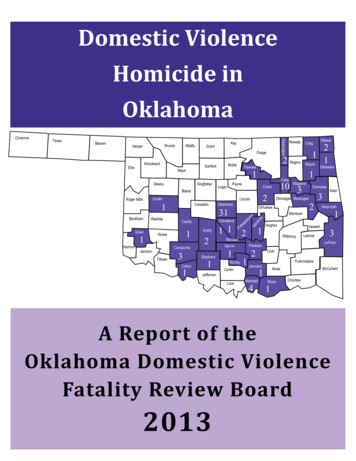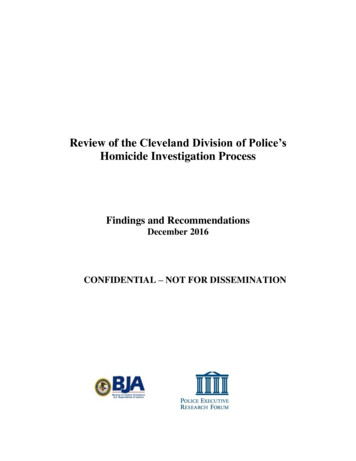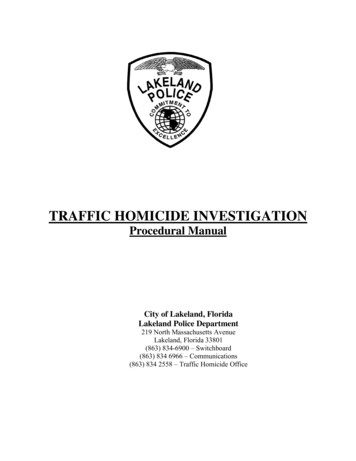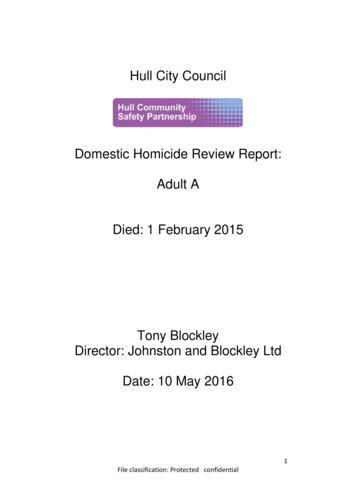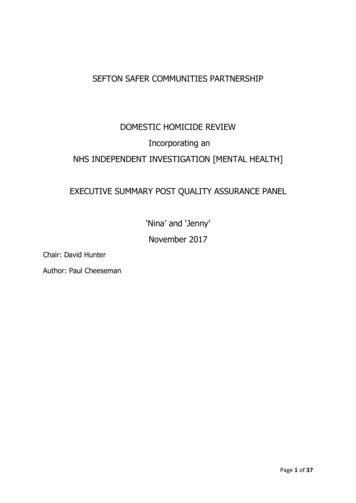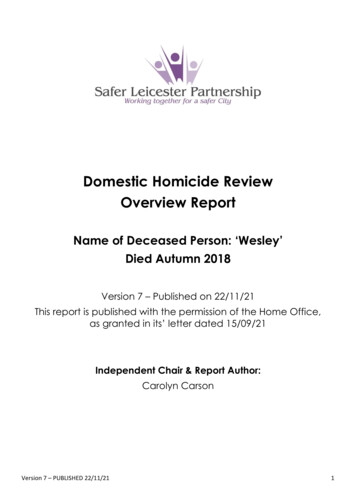
Transcription
Domestic Homicide ReviewsKEY FINDINGS FROM ANALYSIS OF DOMESTIC HOMICIDE REVIEWSDecember 2016
Contents1 Introduction . 22 Key Findings . 3General . 3Intimate Partner Homicide . 3Familial Homicide . 33 Homicide Index: What we know about domestic homicide . 54 Analysis of Domestic Homicide Reviews . 75 Analysis of DHR recommendations . 326 Supporting local areas to deliver a coordinated response to domestic abuse . 34Annex A: Analysis of Homicide Index – Additional Table . 36Annex B: Analysis of Domestic Homicide Reviews: detailed methodology . 40Annex C: Framework . 42Annex D: Attributes of familial homicide DHRs . 44Annex E: DHR coding results. 43Annex F: Further Reading . 43Domestic Homicide Reviews 1
1 Introduction1.A Domestic Homicide Review (DHR) is a multi-agency review of the circumstances inwhich the death of a person aged 16 or over has, or appears to have, resulted fromviolence, abuse or neglect by a person to whom they were related or with whom theywere, or had been, in an intimate personal relationship, or a member of the samehousehold as themselves. Since 13 April 2011 there has been a statutory requirement forlocal areas to conduct a DHR following a domestic homicide that meets the criteria.2.Since April 2011, in excess of 400 DHRs have been completed. DHRs provide a richsource of information on the nature of domestic homicide, the context in which it occursand, most importantly, in the lessons that can be learned from the tragic event. Thisanalysis sets out what we know about domestic homicide and draws out common themesand trends and identifies learning that emerged across the sample of DHRs.3.The purpose of this analysis is to promote key learning and trends from the sample ofDHRs with the aim of informing and shaping future policy development and operationalpractice both locally and nationally.4.We encourage local areas to reflect on the learning identified and to consider how this canbe used to deliver improvements to practice within their local context furthering their abilityto safeguard victims and prevent domestic homicide.5.This paper also reports on what is being done nationally to tackle these issues.2 Domestic Homicide Reviews
2 Key FindingsStatisticsGeneral In 2014/15 there were 50 male and 107 female domestic homicide victims (which includesintimate partner homicides and familial homicides) aged 16 and over. Although the number of both male and female domestic homicide victims fluctuated from yearto year, there is a clear downward trend. Among women, the majority of domestic homicide victims were killed by a partner / expartner. Among both men and women the highest proportion of domestic homicides was among thoseaged 30 to 50 (around two-fifths). The most common method of killing for both male and female domestic homicide victims wasby a knife or other sharp instrument. The majority of principal suspects in domestic homicide cases were male (87% for combinedyears 2010/11 to 2014/15) and nearly one half were aged between 30 and 50 years old.Intimate Partner Homicide Of the 33 intimate partner homicides considered as part of this analysis, just under half (15cases) included dependent children in the family structure. Mental health issues were present in 25 of the 33 intimate partner homicides. In just over half of all DHRs (21), substance use was mentioned. In 24 of the 33 intimate partner homicides, the perpetrator had a history of violence. In six cases the victim had a history of violence towards the perpetrator.Familial Homicide Of the 40 cases analysed, seven were familial homicides. All involved a male perpetrator who committed the homicide. Six of these cases involved the son killing a parent; in one case it was the father. Mental health issues were factors in all seven cases. Substance use by the perpetrator was also noted in all but one familial homicide cases.Domestic Homicide Reviews 3
Main Findings The most common theme occurring in intimate partner homicide DHRs was record keeping.This was highlighted as an issue in 28 out of 33 (85%) intimate partner homicide DHRssampled. Risk assessment was the next most commonly occurring theme with 27 out of 33 DHRs(82%) highlighting this as an issue. Communication and information sharing between agencies was identified as an issue in 25out of 33 (76%) DHRs sampled. There were 24 cases (73% of those sampled) where victims or perpetrators presented toagencies with possible signs of domestic abuse and/or domestic violence but this was notrecognised or explored further. Across the four years in which the DHRs in this sample were analysed, there were a total of600 recommendations made by these DHRs. Although recommendations made to each agency will have been affected by the exactcircumstances surrounding each DHR and the way in which recommendations were capturedin DHRs, Community Safety Partnerships (CSP) and health bodies were identified as havingthe highest proportion of recommendations (both around a quarter of all recommendations)across the four years. In 2013, agencies receiving the largest proportion of recommendations were in the healthsector, in both 2014 and 2015 this was the CSP and in 2016 the highest proportion ofrecommendations was for the police. Across all four years, training was consistently the highest proportion of recommendations.4 Domestic Homicide Reviews
3 Homicide Index: What we know aboutdomestic homicide6.Data presented here have been extracted from the Home Office Homicide Index, whichcontains detailed information about each homicide recorded by police in England andWales. It is continually updated with revised information from the police and the courts.7.The term ‘homicide’ covers the offences of murder, manslaughter and infanticide.However, it should be noted that the threshold for conducting a DHR is lower than thecriminal threshold. A DHR should be conducted “when the death of a person aged 16 orover has, or appears to have, resulted from violence, abuse or neglect ”1. So, forexample, a DHR may be conducted on an apparent suicide, where it appears the suicidewas caused by abuse, but such a case would not be logged in the Homicide Index.8.Homicide Index data are based on the year when the offence was first recorded, not whenthe offence took place or when the case was heard in court. While in the vast majority ofcases the offence will be recorded in the same year as it took place, this is not always thecase. The data refer to the position as at 13 November 2015, when the Homicide Indexdatabase was ‘frozen’ in order for analysis to be conducted2. These data will change assubsequent court hearings take place or as other information is received.Domestic homicide victims9.The definition of domestic homicide used here approximates to that used in DHRs andincludes victims killed by a partner/ex partner3 or a relative or by someone else living withthe victim at the time of the killing.10. In 2014/15, there were 50 male and 107 female domestic homicide victims aged 16and over.11. Figure 1 shows the trend in the number of domestic homicides for men and women aged16 and over since 2007/08. Although the number of both male and female domestichomicide victims fluctuated from year to year, there is a clear downward trend.12. Among women, the majority of domestic homicide victims were killed by a partner/expartner (76%, for combined years 2010/11 to 2014/15), with a further 20% (on average)killed by a relative and the remaining by another household member. There was no clearpattern among men, with a fairly equal split between the three categories (Table A1 –Annex A). Among both men and women, the highest proportion of domestic homicideswas among those aged 30 to 50 (around two-fifths) (Table m/uploads/attachment data/file/97881/DHR-guidance.pdfInformation from the Homicide Index is published annually, in the Office for National Statistics series: Focus on: Violence andSexual Offences.This differs from the definition used in the Focus on violence release as it excludes ‘emotional rival’.Domestic Homicide Reviews 5
Figure 1: Domestic homicide offences currently recorded by the police inEngland and Wales, by gender of victim, aged 16 and over - 2007/08 to 2014/15All domestic homicidesMale domestic homicidesFemale domestic homicides200180Number of 2010/112011/122012/132013/142014/15Method of killing13. In all years shown, the most common method of killing for both male and female domestichomicide victims aged 16 and over was by a knife or other sharp instrument, with 73 suchhomicides (46% of the total) recorded in 2014/15. The second most common method ofkilling in 2014/15 for female domestic homicide victims was ‘strangulation/asphyxiation’,accounting for 29 homicides (27% of the total for women). There was no consistent patternamong male victims.Location of the homicides14. The majority (87%, or 137 offences) of all domestic homicide cases in 2014/15 occurred ina house or dwelling. This proportion was similar in all the years shown in the table. Thepattern was similar for males and females.Age of Suspects15. Table A1 shows the age and gender of the principal suspect in domestic homicide cases.The majority (87% for combined years 2010/11 to 2014/15) were male and nearly one halfwere aged between 30 and 50 years old.Ethnicity16. Ethnicity of the victim and perpetrator was often missing from the DHRs sampled and ithas not, therefore, been possible to capture this data from reports. As a result, the revisedstatutory guidance on conducting DHRs will invite report authors to record key informationof the parties involved, such as age, gender, ethnicity and other characteristics.6 Domestic Homicide Reviews
4 Analysis of Domestic Homicide ReviewsMethodology17. The 40 DHRs included in this analysis were sampled from 195 DHRs that were assessedas suitable for publication, having been quality assured by the Home Office QualityAssurance (QA) Panel between January 2013 and March 2016. Further details on how the40 DHRs were selected can be found in Annex B.18. The case attributes were analysed for each of the DHRs to explore the types of domestichomicide (classified as either familial or intimate partner) and the characteristics of thoseinvolved (e.g. the age and gender of victims and perpetrators). Only seven familial caseswere found in the sample. This is consistent with findings elsewhere4 showing that themajority of domestic homicides are perpetrated within an intimate partner relationshiprather than familial or other domestic arrangement. Due to the small number of familialhomicide DHRs and the known differences between violence perpetrated in intimaterelationships and that between family members, only intimate partner homicide DHRswere included in the main analysis to avoid conflating issues within the findings.19. Content analysis of the case histories contained within the 33 intimate partner homicideDHRs was performed. These histories were coded using qualitative analysis software5.Coding was based on a framework developed and widely used in the health context forunderstanding adverse events6. The framework covers seven broad categories of factors.These categories cover the individuals involved in the case, issues relating to theidentification and handling of cases, and issues with how cases were managed acrossdifferent organisations (the framework can be found in Annex C). These seven categoriesrepresent both national and local policy issues. It is not possible to determine whethereach category represents exclusively national or exclusively local policy issues as someissues may be directed by national policy but their implementation and delivery is guidedby local policy.20. Only incidents during case histories that were considered directly relevant to the homicidewere coded. Deciding whether an incident was ‘directly relevant’ was informed by knownrisk factors from academic literature and/or whether the DHR author had noted that thiswas a key event prior to the homicide. Following the coding process, key areas ofcommonality between the case histories were drawn out into themes, which were analysedin greater detail to determine common underlying issues.21. The number of DHRs in which each code was identified were counted in order to identifyrecurring themes that could highlight aspects of agency working that could be improved.The most commonly occurring themes were further analysed for the frequency with whichdifferent agencies (e.g. the police, social services, health etc.) were mentioned. Whileeach set of circumstances leading up to a domestic homicide is unique, efforts were madeto further group details together under each theme in order to draw conclusions aboutlessons that could be learned to improve practice.456Standing Together Against Domestic Violence and analysis of the Home Office Homicide Index (section 1) showing that themajority of domestic homicides are perpetrated within an intimate partner relationship.NVivoVincent et al. (1998). Some of the factor headings have been re-named to make them more relevant for this analysis.Domestic Homicide Reviews 7
Key limitations of the analysis The coding was constrained by the quality and content of the reports themselves, whichvaried in length, structure and writing style. The content of the reports differed, for examplesome reports included a separate chronology of events and analysis, whilst other reportscombined the chronology and analysis. This meant that the same event may have beencoded twice in some DHRs. This analysis focused on the case histories presented in the reports and did not identifycommonalities between other sections of DHRs, such as recommendations made to localareas. A separate analysis of the recommendations made by the DHRs sampled is detailedlater in the report. Decisions about which passages to code are likely to be affected by the subjective opinionof the coder. Wherever possible, decisions about coding were based on academicliterature of risk factors associated with domestic homicides.Case Attributes Analysis22. In order to explore the circumstances around domestic homicides and any commonalitiesthat may be present, various case attributes were analysed.23. As set out in the methodology, the following findings relate to the 33 intimate partnerhomicide DHRs. Attributes of the seven familial homicide DHRs are included in Annex Dfor information.Gender24. Of the 33 intimate partner homicide DHRs the majority (29) involved a male perpetratorand female victim(s). In the remaining four DHRs the victim was male and the perpetratorwas female. The sample did not include any homicides involving same sex relationships.Age25. The most common age group for perpetrators of intimate partner homicide in the DHRsanalysed was 51-60 years of age (8). This was followed by the 21-30 age group (7). Forvictims, the two most common age groups were 21-30 and 31-40 (both n 7) Table 1.Table 1: Frequency of age groups for perpetrators and victims involved in intimatepartner homicide DHRsCount of DHRs involvingperpetrators in each age groupCount of DHRs involvingvictims in each age group11 201121-307731-406741-506651-608661-703271-801080 11DHRs involving multiple victims/perpetrators033333Age groupsTotal number of DHRs8 Domestic Homicide Reviews
Dependent children26. Of the 33 intimate partner homicide DHRs, the family structure included dependentchildren in 15 cases, with no dependent children in the remaining 18 cases. In the majorityof the 15 DHRs with dependent children, the victim and perpetrator were the parents of thedependent children (11).27. DHRs were further examined to see whether children witnessed or were affected by anyabuse, violence or the homicide itself. This was the case in 12 of the 15 DHRs involvingdependent children.Mental health28. Mental health issues were present in 25 of the 33 intimate partner homicide DHRs.Twenty-one cases involved perpetrators with mental health issues: 15 cases where onlythe perpetrator had mental health issues and six cases where both the perpetrator and thevictim had mental health issues. The remaining four cases involved victims with mentalhealth issues but not perpetrators.29. Of the 21 DHRs involving perpetrators with mental health issues, the majority (16) wereknown to health professionals. Of the 10 DHRs involving victims with mental health issues,all were known to health services. Table 2 shows the different types of mental healthissues mentioned in the DHRs.Table 2: Frequency and type of mental health issues for perpetrators and victimsinvolved in intimate partner homicide DHRsCount of DHRs involvingperpetrators with mental health issuesCount of DHRs involvingvictims with mental healthissuesDepression119Psychosis3-Self harm31Suicidal thoughts31Suicide attempt21Low mood/anxiety (no diagnosis)2-Adjustment disorder1-PTSD1-Anxiety1-Panic attacks--Not specified112110Total number of DHRsSubstance use30. Substance use was mentioned in 20 DHRs: nine DHRs mentioned substance use by theperpetrator only, two by the victim only and nine by both the perpetrator and victim.31. In seven of the 20 DHRs where substance use was mentioned, this was not reported tohealth services. In the remaining 13 DHRs, the substance use was known to healthservices as being problematic. Table 3 shows the breakdown of substance use by types.Domestic Homicide Reviews 9
Table 3: Frequency and type of substance use issues for perpetrators and victimsinvolved in intimate partner homicide DHRsCount of DHRs involvingvictims with substance useissuesAlcohol10Drugs4Alcohol & Drugs6Co-occurrence of substance use and mental health issues32. Among perpetrators and victims the presence of both substance use and mental healthissues was more common than either issue occurring alone. For example, 12 DHRsinvolved perpetrators and seven involved victims with both mental health and substanceuse issues (Figure 2).33. It is important to note that both substance use and mental health issues individually ortogether amongst perpetrators and victims are aggravating factors that escalate violencein relationships already abusive.Figure 2: Frequency of DHRs involving perpetrators and victims with only mental healthissues, only substance use issues and both mental health and substance use euse127PerpetratorsVictimsHistory of violence34. In 24 of the 33 intimate partner homicide DHRs the perpetrator had a history of violence. Inseven of these cases the history of violence was not known to any agency. Of the other 17cases, agencies had recent knowledge of this in 12 cases.35. In 13 of the 24 DHRs where the perpetrator had a history of violence, the violencementioned was towards the victim only. Of the remaining 11 DHRs, nine had a history ofviolence towards others, seven had a history of violence towards women specifically, andsix had a history of general criminality.736. In six cases the victim had a history of violence towards the perpetrator. The victim wasfemale in four of these cases and male in the remaining two. The violence was mutual inall six cases and was associated with significant relationship strain and other stressors,such as substance use. While not clear from the DHR case histories, an element of thismay be retaliatory violence from a perpetrator, who themselves have experiencedprolonged abuse. Due to the small number of cases included in the current analysis, it is7Categories are overlapping (a perpetrator may have a history of violence to others and a history of general criminality) so totalcomes to more than 11.10 Domestic Homicide Reviews
difficult to draw firm conclusions. Research into risk factors for domestic abuse hashowever shown that female violence towards a partner increases their risk ofvictimisation.8Analysis of common themes37. From the coding framework used to categorise content in the DHRs the number of casesin which each code was identified were counted in order to identify recurring themes thatcould highlight aspects of agency working that could be improved. The most commonlyoccurring themes were further analysed for the frequency with which different agencieswere mentioned and the detail of the circumstances. While each set of circumstancesleading up to a domestic homicide is unique, efforts were made to further group detailstogether under each theme in order to draw conclusions about lessons that can be learnedto improve practice.Figure 3: Frequency of themes mentioned in intimate partner homicide DHRsCommon issues related to record keeping28Cases where record keeping was highlighted as an issueFrequency of agencies mentioned in relation to issues with record keeping38. The number of times different agencies were mentioned across the 33 intimate partnerhomicide DHRs in relation to issues with record keeping were counted. Each agency /Documents/DA ROR Summary 14-12-15.docDomestic Homicide Reviews 11
only been counted once per DHR, although they may have been mentioned multiple timesin relation to record keeping. Health (e.g. GP, hospital, health visitor, mental health) – 21Police – 12Social services – 10Probation – 1Other (school, housing, prison) – 9Common issues related to record keeping39. In all 28 cases, there were examples of poor quality or inadequate records. This wasparticularly the case for GP records.40. In 12 of the cases highlighted here, there were instances where no records were found.This meant that there were instances where it was not possible to know if an expectedaction had not been taken, or that action had been taken without being documented.41. Linked to the issue of information sharing and communication, there were 9 cases whereinformation systems meant that records were not properly shared within or betweenorganisations.“Organisations should seek to have systems in place that allow those responding toincidents to be provided with the previous history to enable them to provide the bestsupport to the victim and assess the incident in the light of a developing pattern ofbehaviour.”“[Police] knew that [the victim] has a non-molestation order and was a high risk victim ofdomestic violence, yet their databases did not contain her current address.”42. In four cases records were lost, destroyed, or unavailable. This was particularly the casewhere paper records were still in use. This created problems not just for the review team inestablishing evidence, but also for practitioners at the time the events were occurring12 Domestic Homicide Reviews
Issues in relation to risk assessment27DHRs identified issues with risk assessmentFrequency of agencies mentioned in relation to issues with risk assessment Health (e.g. GP, hospital, health visitor, mental health) – mentioned in relation to issueswith risk assessment in 13 Police – 12 Social services – 10 Other (Local Authority, housing, youth offending) – 5 Probation – 3Common issues related to risk assessment43. In order to further understand the context for issues with risk assessment the detail of thistheme was further examined and particularly frequently occurring elements were noted. Ofthe 27 cases where the DHR identified issues with risk assessment there were: 14 DHRs where risk assessment was not completed when it should have been.“If there is doubt as to who is the victim and who is the perpetrator best practice wouldhave been to complete 2 DASH forms, one for each party”“There is no record of sexual risk assessment framework (SERAF) assessment beingcompleted”. Five DHRs where risk assessment was of poor quality, such as generally lacking detailor failing to fully interrogate circumstances.“However, this approach was not based on good quality risk assessment and theresulting effectiveness of support plans was therefore compromised”.Domestic Homicide Reviews 13
Five DHRs where risk assessment was given an incorrect rating, for example whereDASH was graded as standard when the situation warranted at least a medium grading(e.g. threats to kill had been made or there were multiple DV incidents in the previous12 months). Four DHRs where incidents were assessed in isolation. This was an issue in terms ofindividual agencies, for example police officers assessing each incident as separate sono pattern was observed, previous incidents not being used to inform subsequent riskassessment and issues with agencies assessing risk in isolation from each other.“It appears that the repeated domestic incidents involving [the victim] and [theperpetrator] were considered and risk assessed by the police as individual incidents.” Three DHRs where domestic abuse incidents were not recorded as domestic abuse, forexample where incidents were logged as other types of incidents, such as criminaldamage, civil dispute, anti-social behaviour.14 Domestic Homicide Reviews
Issues with the identification or understanding of domesticviolence and abuse24Cases where victims or perpetrators presented to agencies withpossible signs of domestic violence and abuse but this was notrecognised or explored furtherFrequency of agencies mentioned in relation to issues with identification orunderstanding of domestic violence and abuse Health (e.g. GP, hospital, health visitor, mental health) – 16Police – 10Social services – 8Other (school, housing) – 3Probation – 2Common issues related to identification or understanding of domestic violence andabuse44. Of the 24 cases where the DHR highlighted issues with identifying or understandingdomestic violence and abuse: 13 DHRs where elements of the case or risk factors were not fully explored.“Although [the victim] was under 18 years of age, the principle of a domestic abuseinvestigation should have been considered.” Nine DHRs where vulnerability issues were overlooked. This included instances relatedto not recognising times when vulnerability is heightened (e.g. following a separation orduring pregnancy) and others were around social services focusing on the protection ofchildren but overlooking the vulnerability of a mother. In one case, as highlighted by thequote below, the fact that the victim was male was felt by the DHR panel to impact onagencies’ view of his vulnerability:“The panel is of the view that his gender, together with agencies’ perceptions of him andhis lifestyle, played a part in the failure to recognise [the victim’s] vulnerability.”Domestic Homicide Reviews 15
Nine DHRs where non-physical violence elements were not taken seriously (e.g.coercion and control, threat to kill, sexual exploitation, grooming, stalking andharassment). Seven DHRs where there were missed opportunities to investigate or intervene.“Had [the victim’s] file been ‘flagged’ for domestic abuse it may have resulted in the GPmaking further enquiries when she presented for stress”. Six DHRs identified that there should have been routine enquiry but this did not takeplace. In three of these cases this was because either the perpetrator or other familymembers were present and it was rightly felt to be inappropriate, but no efforts weremade to follow up. In other cases there is simply no evidence of inquiry where thisshould have been recorded. While not as common, there were also issues around identification in terms of the ageand gender of parties involved. Three of the cases involved young persons who agenciesstruggled to determine whether to treat as a child or adult and subsequently failed toeither identify the domestic violence occurring or protect them as a child. There were alsoinstances where the male partner was the eventual victim of the homicide but the DHRrevealed that agencies failed to identify the risks and vulnerability, either due to thegender of the victim or because they did not adequately recognise that instances ofmutual violence may have been retaliatory and therefore identify the risks to both parties.16 Domestic Homicide Reviews
Communication and information sharing issues both intraagency and between agencies25Cases where issues were identified with communication orinformation sharing between agenciesFrequency of agencies mentioned in relation to communication or information sharingbetween agencies Health (e.g. GP, hospital, health visitor, mental health) – 15Police – 14Social services – 9Local Authority – 5Probation – 4Other (housing, education) – 3Common issues related to communication or information sharing between agencies45. In t
Domestic Homicide Reviews 7 4 Analysis of Domestic Homicide Reviews Methodology 17. The 40 DHRs included in this analysis were sampled from 195 DHRs that were assessed as suitable for publication, having been quality assured by the Home Office Quality Assurance (QA) Panel between January 2013 and March 2016. Further details on how the
